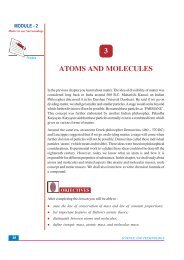Chapter 20. Perimeters and Area of Plane Figures
Chapter 20. Perimeters and Area of Plane Figures
Chapter 20. Perimeters and Area of Plane Figures
You also want an ePaper? Increase the reach of your titles
YUMPU automatically turns print PDFs into web optimized ePapers that Google loves.
MODULE - 4<br />
Mensuration<br />
<strong>Perimeters</strong> <strong>and</strong> <strong>Area</strong>s <strong>of</strong> <strong>Plane</strong> <strong>Figures</strong><br />
Therefore, area <strong>of</strong> trapezium ABCD = 2<br />
1 (AB + CD) × BF<br />
Notes<br />
= 2<br />
1 (11 + 25) × 12 cm<br />
2<br />
= 18 × 12 cm 2 = 216 cm 2<br />
CHECK YOUR PROGRESS <strong>20.</strong>2<br />
1. Find the area <strong>of</strong> a triangle <strong>of</strong> sides 15 cm, 16 cm <strong>and</strong> 17 cm.<br />
2. Using Heron’s formula, find the area <strong>of</strong> an equilateral triangle whose side is 12 cm.<br />
Hence, find the altitude <strong>of</strong> the triangle.<br />
<strong>20.</strong>3 AREAS OF RECTANGULAR PATHS AND SOME<br />
RECTILINEAR FIGURES<br />
You might have seen different types <strong>of</strong> rectangular paths in the parks <strong>of</strong> your locality. You<br />
might have also seen that sometimes l<strong>and</strong>s or fields are not in the shape <strong>of</strong> a single figure.<br />
In fact, they can be considered in the form <strong>of</strong> a shape made up <strong>of</strong> a number <strong>of</strong> polygons<br />
such as rectangles, squares, triangles, etc. We shall explain the calculation <strong>of</strong> areas <strong>of</strong> such<br />
figures through some examples.<br />
Example <strong>20.</strong>10: A rectangular park <strong>of</strong> length 30 m<br />
<strong>and</strong> breadth 24 m is surrounded by a 4 m wide path.<br />
Find the area <strong>of</strong> the path.<br />
Solution: Let ABCD be the park <strong>and</strong> shaded portion<br />
is the path surrounding it (See Fig. <strong>20.</strong>3).<br />
So, length <strong>of</strong> rectangle EFGH = (30 + 4 + 4) m = 38 m<br />
<strong>and</strong> breadth <strong>of</strong> rectangle EFGH = (24 + 4 + 4) m = 32 m<br />
Fig. <strong>20.</strong>3<br />
Therefore, area <strong>of</strong> the path = area <strong>of</strong> rectangle EFGH – area <strong>of</strong> rectangle ABCD<br />
E<br />
H<br />
A<br />
C<br />
30 m<br />
B<br />
24 m<br />
D<br />
F<br />
G<br />
= (38 × 32 – 30 × 24) m 2<br />
= (1216 – 720) m 2<br />
A<br />
P Q<br />
B<br />
= 496 m 2<br />
Example <strong>20.</strong>11: There are two rectangular paths in<br />
the middle <strong>of</strong> a park as shown in Fig. <strong>20.</strong>4. Find the<br />
cost <strong>of</strong> paving the paths with concrete at the rate <strong>of</strong><br />
` 15 per m 2 . It is given that AB = CD = 50 m,<br />
AD = BC = 40 m <strong>and</strong> EF = PQ = 2.5 m.<br />
H<br />
G<br />
D<br />
M L<br />
O N<br />
S R<br />
Fig. <strong>20.</strong>4<br />
C<br />
E<br />
F<br />
464<br />
Mathematics Secondary Course

















